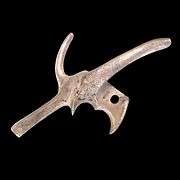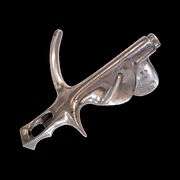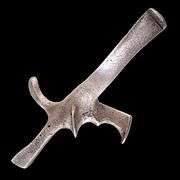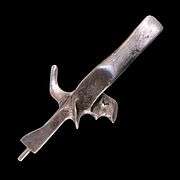Grip (sport fencing)
In fencing, the grip, also called the handle, is the part of the weapon which is gripped by the fencer's hand.
There are two types of grips commonly used today in competitive foil and épée: French, which is a straight grip with a pommel at the end of it, and the orthopedic or pistol grip. Virtually all high level foil fencers use a pistol grip; in épée, both types are used. Both kinds of grip optimize hitting with the point of the sword (a 'thrust'), which is the only way to score a touch with a foil or épée.
There are a number of grips which are no longer common or are currently illegal in competitive fencing. The Italian grip is legal but is not used commonly. A number of grips, including the Dos Santos, the Gardere, and the Spanish, which combine a French grip pommel with pistol grip style prongs, are illegal for competition. The rationale for these grips being illegal is that they would allow both the extended reach of the French and the added strength of the pistol grip.
Sabre, which is the only fencing weapon that allows "cutting" with the edge of the blade, has only one kind of grip, because of the way the blade is handled. Sabre grips are generally made of plastic, rubber over metal or plastic, wood, or leather wrapped over wood.
French grip
The French grip is contoured to the curve of the hand and reached its modern form in the late nineteenth century. Compared to the other primary grip used in modern sport fencing, the pistol grip, the French is thought to have greater speed and maneuverability, but less strength and stability. The French grip also allows the fencer to "post", holding the grip towards the pommel, instead of holding the weapon near the bell guard. This gives the fencer a longer reach while lessening strength and stability, and allows for an expanded repertoire of counterattacks and remises of attacks.
Pistol grip

The pistol grip (otherwise known as the anatomical or orthopedic grip) was originally developed for a nineteenth-century Italian aristocrat, L. Visconti, master of fencing, who lived in Belgium and had lost fingers in a tram accident. It contours entirely to one's hand and is held much like a pistol, hence the name. This grip has become popular among sports fencers in the late twentieth century because of the way it enhances a fencer's lateral strength for the parry (block) and complements the agility and athleticism of competitors, though, critics allege, at the cost of blade sensitivity finesse. There are several types of pistol grips, such as the basic Visconti, the German, and the Russian (any of which are what most people refer to as a pistol grip), and the American, all providing a somewhat firmer hold for the user of the weapon. The subtle variations in the pistol grip may correspond loosely to different fencing styles.
In high-level fencing, pistol grips are universally preferred in foil, and are used by a large percentage of épée fencers because they allow stronger blade movements. A substantial number of épéeists at all levels use French grips while posting (holding the grip near the pommel instead of the guard) because of the longer reach. Posting is almost unheard of in foil, as it decreases one's ability to parry successfully, and thus increases an opponent's chance of a successful hit or remise.
Types of pistol grips
(these names vary by country)
- Visconti
- Belgian
- Russian
- American
- Hungarian
- German
- Zivkovic (American in-house produced model)[1]
- Cetrulo**
- Gardere (hybrid between the French and pistol grips)**
- Spanish**
| Ergonomic handles | ||||||||||||
|---|---|---|---|---|---|---|---|---|---|---|---|---|
|
** Illegal in FIE level competition
Italian grip

The Italian grip, evolving from the handle of the rapier (Renaissance) and its later progeny, the smallsword (Baroque period), is rarely used today in sport fencing today, but is common among classical fencers. In the 1940s and 50s, it was very popular with sport fencers in America and many other countries, until being supplanted by the pistol grip. Its advocates say that it has most of the French grip's agility with a much greater degree of power and stability. The Italian grip consists of a straight handle, usually wood or aluminium covered in grip tape, as well as a crossbar (the quillions), and two rings. The fencer's fingers actually rest upon the ricasso, which is part of the blade. This not only gives great security, but great sensitivity. Because of the smaller length of the handle, and particulars of the Italian style of bladework, the Italian grip is used with a "martingale" which is either a leather strap around the wrist into which the pommel is tucked, or an elastic bandage which is wrapped completely around the hand.
References
| Wikimedia Commons has media related to Orthopedic fencing handle. |
- ↑ Zivkovic handles, accessed on 20 November 2006






